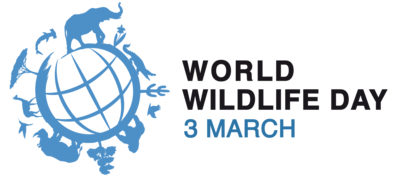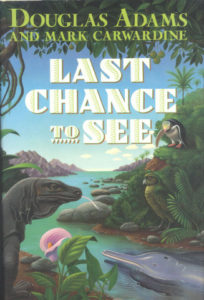 Join us in celebration of March 3rd, World Wildlife Day! The UN urges us to “Listen to the Young Voices,” because they are the ones who face a world with the possibility of a vast reduction in wildlife due to the actions of their ancestors. They’ve grown up singing about the wolf crying to the blue corn moon and the grinning bobcat, but may soon face a planet where those lyrics will be the only way to remember them. But the young voices are also what give us hope. Hope that amongst the perils of wildlife conservation, there are individuals around every river bend ready to stand up to protect their planet, and who can change the outcome day by day.
Join us in celebration of March 3rd, World Wildlife Day! The UN urges us to “Listen to the Young Voices,” because they are the ones who face a world with the possibility of a vast reduction in wildlife due to the actions of their ancestors. They’ve grown up singing about the wolf crying to the blue corn moon and the grinning bobcat, but may soon face a planet where those lyrics will be the only way to remember them. But the young voices are also what give us hope. Hope that amongst the perils of wildlife conservation, there are individuals around every river bend ready to stand up to protect their planet, and who can change the outcome day by day.
Given that almost one quarter of the world’s population is aged between 10 and 24, vigorous efforts need to be made to encourage young people, as the future leaders and decision makers of the world, to act at both local and global levels to protect endangered wildlife.
Here’s the situation: gains and losses in conservation news within the last year or so…
Gains:
- 150 million acres of the Amazon Rainforest are now strictly protected or limited only to sustainable use- a region that is home to 1 in 10 known species on earth. Deforestation in the Amazon has fallen by 75% in the past decade.
- The US adopted tighter regulations on the ivory trade. Now in the United States, selling across state lines and exporting ivory is only allowed in few circumstances. China (who has the biggest ivory market in the world) announced a ban on all domestic ivory trade by the end of 2017.
- Bison named as US National Mammal which draws attention to the animal in hopes of preventing extinction.
- The Fall of 2016 meeting of CITES banned or highly limited international trade on several critically endangered species including pangolins (hunted for their scales), African grey parrots, and several species of sharks (hunted for shark fin soup).
- Giant pandas are no longer considered endangered on the IUCN Red List thanks to an increase in available habitat, confirming that government reforestation and forest protection acts are working.
- Globally protected areas – clearly defined regions managed through legal and other means to achieve long term conservation- both on land and more critically in the ocean are expanding each year, making it easier to protect biodiversity.
- Commercial whaling has been significantly restricted in Japan. Additionally the US Navy has agreed to reduce their use of explosive testing in habitats of endangered marine mammals.
- The Alliance for Water Stewardship introduced the first global framework used to promote and recognize sustainable water use, a huge victory for all of the wildlife that depend on freshwater.
- The Paris Agreement, the first global framework put forth by the UN to combat climate change, was officially entered into force in November 2016. This agreement works to prevent global temperatures increases this century from reaching beyond 2 degrees above pre-industrial levels. Curbing climate change preserves wildlife habitat.
- Tiger numbers are on the rise for the first time in 100 years. Around 3,890 tigers now exist in the wild, an increase from the previous 3,200 reported in 2010.
Losses:
- Giraffes have been added to the list of endangered species.
- The eastern gorilla, whose population is now below 5,000, is being driven to extinction by poaching. The ease of access to firearms in response to the civil wars is a major factor.
- The Bramble cay melomys, a tiny island rodent species, became the first mammal whose extinction was caused directly by climate change.
- New data reports from the Great Elephant Census say that Africa has lost a third of its elephants in the last 7 years due to the illegal ivory trade. 96 elephants are killed in Africa each day.
- The US Environmental Protection Agency has been barred from issuing any new grants and is under a media blackout amongst other agencies like the National Park Service.
- The USDA recently removed all previously public reports of animal welfare that were used in fighting inhumane treatment of animals in labs, circuses, puppy mills, shelters, etc.
- The largest coral bleaching event to ever occur in the Australian Great Barrier Reef (the largest coral reef in the world) was recorded in November of 2016. This mass death of corals occurs when they are stressed due to warm temperatures from fossil fuels. Coral reefs house some of the most biodiverse ecosystems on the planet.
- This year the IFAW report on the Killing for Trophies concluded that the US was the biggest importer of hunting trophies, accounting for 70% of all import demand.
- Arctic sea ice levels hit a record low this year due to climate change.
Here’s What Youth Are Doing:
Whether it is a small one-day event, or an ongoing community-wide campaign, Roots & Shoots members are making a difference for wildlife.
 Engaging in the political dialogue on climate change
Engaging in the political dialogue on climate change- Harvesting mangroves to bring up the abundance of the regions so crucial to ocean biodiversity
- Maintaining a bee population to increase their abundance and ensure pollination of a community garden
- Using community mapping to determine the utility of a school garden and planting plants that will attract more diverse species
- Bringing awareness to the plight of the most heavily trafficked mammal in the world, the pangolin
- Organizing a community-wide fundraiser for wildlife with fun, innovative ideas to raise money, and activities for all ages
Here’s What YOU Can Do:
- Avoid the use of pesticides in your garden that can run off into water sources in the area and negatively affect the surrounding wildlife.
- Urge FedEx to stop shipping shark fins.
- Take part in Wildlife Week, with an action each day that protects wildlife.
- Download the Monterey Bay Aquarium’s “Seafood Watch” app that allows you to easily search for ocean-friendly seafood served in your area.
- Download the “Sustainable Palm Oil Shopping Guide” from your mobile app store to make sure you are making orangutan-friendly choices.
- Make your backyard into a bird sanctuary by using proper feeders and providing nesting and shelter sites. Even bees could use our help with shelter!
- Get in touch with your representatives. There are so many issues that need our advocacy. States can pass bans on ivory trade that would further strengthen the enforcement of federal laws against it in the US. (NY, NJ, CA, WA, HI, OR, MA have already done so!)
- Design your own Roots & Shoots project with your family, friends, or class.
Here’s What You Can READ:
 Last Chance to See – Douglas Adams
Last Chance to See – Douglas Adams
The Lorax – Dr. Seuss
A Silent Spring – Rachel Carson
A Sand County Almanac – Aldo Leopold
The 6th Extinction – Elizabeth Kolbert
Zoobiquity – Barbara Natterson-Horowitz and Kathryn Bowers
The Future of LIfe – E.O. Wilson
In the Shadow of Man – Dr. Jane Goodall
1001 Ways to Save the Earth – Joanna Yarrow
Guns Germs and Steel – Jared Diamond
The Elephant Whisperer – Lawrence Anthony
Here’s What You Can WATCH:
Racing Extinction
Virunga (Netflix)
The Ivory Game (Netflix)
The Cove
Chasing Ice (YouTube)
Before the Flood
 For Younger Viewers:
For Younger Viewers:
- The Lorax
- Planet Earth
- Born To Be Wild
- Disneynature’s Chimpanzee
Designating one day a year as World Wildlife Day is a great way to remind people of the wonderful creatures of our world and the obstacles they face. But it should certainly not be the only day we have this on the brain! Today should merely be a stepping stone, a launching point for becoming compassionate human beings that live each day with the rest of the planet in mind.




